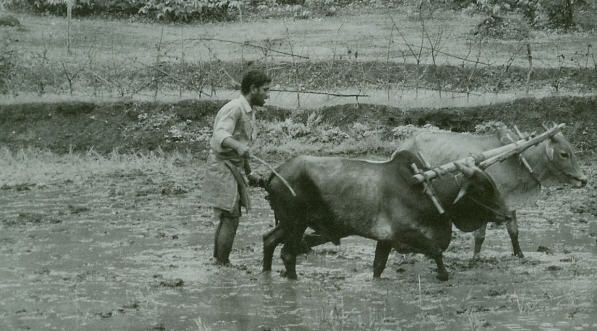
Mutual respect between man and animal is the key to a community's economic base.
JAYA RADHE, a young cow with her first calf, Nandini, walks proudly. It seems she knows she's a descendant of Kamadhenu, the wish-fulfilling cow said in the Puranas to be the original cow. At first Jaya Radhe wouldn't allow us to milk her, but we gained her trust with much petting and coaxing and rubbing under her neck. We didn't like to tie her legs, the common practice; that would have been a battle, and we didn't want to force her. She gives milk now, but when she feels she has reached her limit, she'll kick hard, and further persuasion is useless.
Nandini has become fat and beautiful with plentiful milk from her mother. We don't treat our cows as milk machines, as is done in commercial dairies. There, calves are separated from their mothers and made to suffer the indignity of drinking milk from a bucket or a bottle, or worse starved to death or sent to the slaughterhouse so that the master can have all the milk.
It's the time of the first monsoon rain, and three young oxen Bhima, Nakula, and Sahadeva gallop across the field. Their heads are smeared with soft red earth they've dug up with their horns. They've seen an intruder, a strange bull on their land, so they chase him out, tails and heads held high, snorting, eyes shining brightly, hooves thudding, followed by little black Nandini, who is ready for anything.
Soon they'll be working hard under the yoke of the plow, in the water and deep, soft mud of the rice fields, and they will become quiet and sober. But when all the plowing is over, the farmer will bow down to their feet in respect to thank them and tell them they are free to go. Such reciprocation between man and animal, and the idea of go-seva, or service to the cow, is new to us in the West who have been brought up to believe we are the lords of all we survey and nature is ours to exploit.
My urbanite stepson, a doctor, came to visit and saw the few milking cows in their barn, and then the bull, oxen, and older calves in another cow shed. He was surprised.
"These don't give any milk? What's wrong with them?"
"They're bulls."
"Oh. Why do you keep them then?"
"Are your sons not just as good as your daughters?" I asked.
And I told him that all our cows, bulls, and calves have lifetime protection. I told him that to give milk, a cow must have a calf, who must be engaged and cared for his or her whole life; that bulls are even more important than milking cows because they plow the field, carry loads on the bullock cart, and turn the oil press to extract oil from seeds; and that both cows and bulls produce dung, which is more valuable than gold or even the famous Kohinoor diamond, according to eminent Indian economist Venishakar M. Vasu, because it fertilizes the soil.
The farmland of India had remained fertile for hundreds of thousands of years by the application of cow dung. But now, because of cow slaughter, India has a shortage of cow dung for fertilizer, and chemical fertilizer has ruined the land, killing the soil.
Venishakar M. Vasu says, "If we destroy our cattle wealth, not even God can save this country."
Srila Prabhupada writes in a purport to Srimad-Bhagavatam (3.2.29):
As he [Lord Krsna] grew to be six or seven years old, the Lord was given charge of looking after the cows and bulls in the grazing grounds. He was the son of a well-to-do landholder who owned hundreds of thousands of cows, and according to Vedic economics, one is considered to be a rich man by the strength of his store of grains and cows. Human society needs only sufficient grain and sufficient cows to solve its economic problems. With these two things humanity can solve its eating problem. All other things but these two are artificial necessities created by man to kill his valuable life at the human level and waste his time in things which are not needed.
Lord Krsna, as the teacher of human society, personally showed by His acts that the mercantile community, or the vaisyas, should herd cows and bulls and give protection to the valuable animals. According to smrti regulations, the cow is the mother and the bull is the father of the human being. The cow is the mother because just as one sucks the breast of the mother, human society takes cow's milk. Similarly the bull is the father of human society because the father earns for the children just as the bull tills the ground to produce food grains. Human society will kill its spirit of life by killing the father and the mother.
It is mentioned herein that the beautiful cows and bulls were of various checkered colors red, black, blue, green, yellow, ash, etc. And because of their colors and healthy smiling features, the atmosphere was enlivening.
We can fix our minds on the Lord as He is described in the verse on which Srila Prabhupada is commenting: "While herding the very beautiful bulls, the Lord, who was the reservoir of all opulence and fortune, used to blow His flute, and thus He enlivened His faithful followers, the cowherd boys." And we can do as Srila Prabhupada has instructed us: protect the beautiful cows and bulls and benefit human society.
Lavangalatika Devi Dasi is an American disciple of Srila Prabhupada. She and her Indian husband care for cows on their land in Maharashtra, India.
